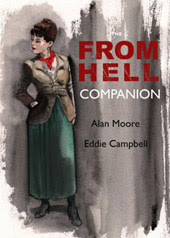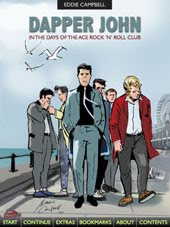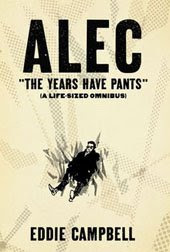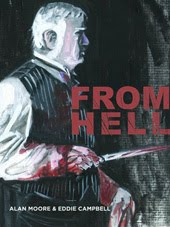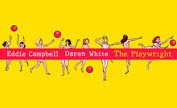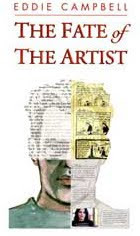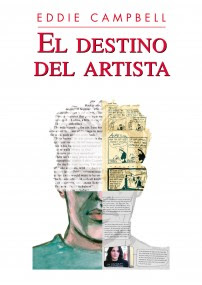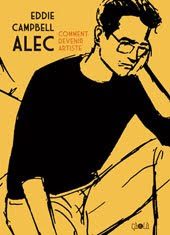
i'm reading the Zadie Smith edited The Book of Other people. I like the way Daniel Clowes (four pages in colour) and Chris Ware (fifteen pages in colour) are presented as authors among other authors, such as Lethem, Foer and Eggers, with the works arranged alphabetically after the name of their titular person. And in the contributors section at the back 'His books include Ghost World etc..." though Ware spoils it at the last minute: "is the author of Jimmy Corrigan- the Smartest Kid on Earth. He is currently serializing two new graphic novels..."
(also of note to my regular readers, Charles Burns draws 13 people on the covers, and Posy Simmonds draws a handful of people in the Nick Hornby contribution, and relevant to yesterday's post, they are 'author photos')
Reading David Mitchell's contribution, I am arrested by an odd linguistic lump of gristle, coming coincidentally not long after some argument over the use of who/whom in comic book circles. "Who do you trust?" is open to being read as a quote of a quote of a quote...
Mitchell gives us these lines:
'June, where the hell is everyone?'
'Who is this and where the hell is who?'
What sort of actress doesn't know her whos from her whoms?
The narrative is in the first person, fictional Judith Castle writing. Since 'who' (as subject of verb 'to be') is correct in the second line (twice), am I to read this as some kind of high irony and an undependable narrator, which would be a dodgy trick in these grammatically confused times, and anyway the rest of the story doesn't support that. Alternatively it may be a typo caused by the unfortunate editorial removal of a letter 'm' from the end of line two. Or am I to ascribe it simply to authorial carelessness?
*************
The second part of
How Art Made the World aired this week here in Australia. Its subject was the first pictures made by humans, in the caves of Altamira and Lascaux, and Dr Nigel Spivey asked the question "How did the first picturemaker make the first picture when he had never seen a picture before?" This is such a true conundrum. I often watch our dog Monty in front of the television. If a dog barks on screen, Monty rushes out of the house to try and find it. In other words, the moving lights on the screen are meaningless to him. He is incapable of seeing pictures there at all. It must have been the same with humans. We had to learn to see a picture and people were around for many many thousands of years before they got around to painting the first one. What made them think of it?
I recall a similar argument I had many years ago on the subject of drawing and painting 'photographically.' I held that an artist logically could not have painted 'photographically' before the invention of the camera. Photographically is to be differentiated from 'realistically'; the seen world registers differently through an eyeball than through a glass lens. I therefore welcomed Hockney's theories claiming that artists were using lenses to project images from life onto their picture surfaces as early as the Renaissance, because it explained a couple of anomalies in my system, like Holbein for instance. The world being a thoroughly stupid place, Hockney's observations were immediately interpreted as a claim that artists had
'cheated,' and the matter was argued vociferously by the
flat earth society over at Artrenewal.com.
******
Following my repeated statement on Tuesday of my fondness for Vince Colletta's work, his granddaughter dropped this comment way back in my original post where it may be overlooked, so I'll copy it to here. Thanks, Katherine..
I'm not sure if this will even be read by anyone but Vincent Colletta was my grandfather and it greatly disturbs me to see the uneccessary, unkind things people have to say about the most wonderful man I have ever had the pleasure of knowing. For the record this man was entirely dedicated to his work and was passionate about it until the very end. I should know I was there- watching him day after day in his basement at his drawing table putting forth everything he had to the point we didn't really have much time to spend together. As long as I was quiet and behaved he would let me sit next to him and I will never forget those memories. I ask to all those with their negative comments to try and exude some class and respect for a man that truly loved his family and worked so incredibly hard to create works of art for millions of people to enjoy. Lets not forget that no one, INCLUDING YOURSELVES, are perfect- we all try as best we can.
Labels: art (2), monty, new books (2)






